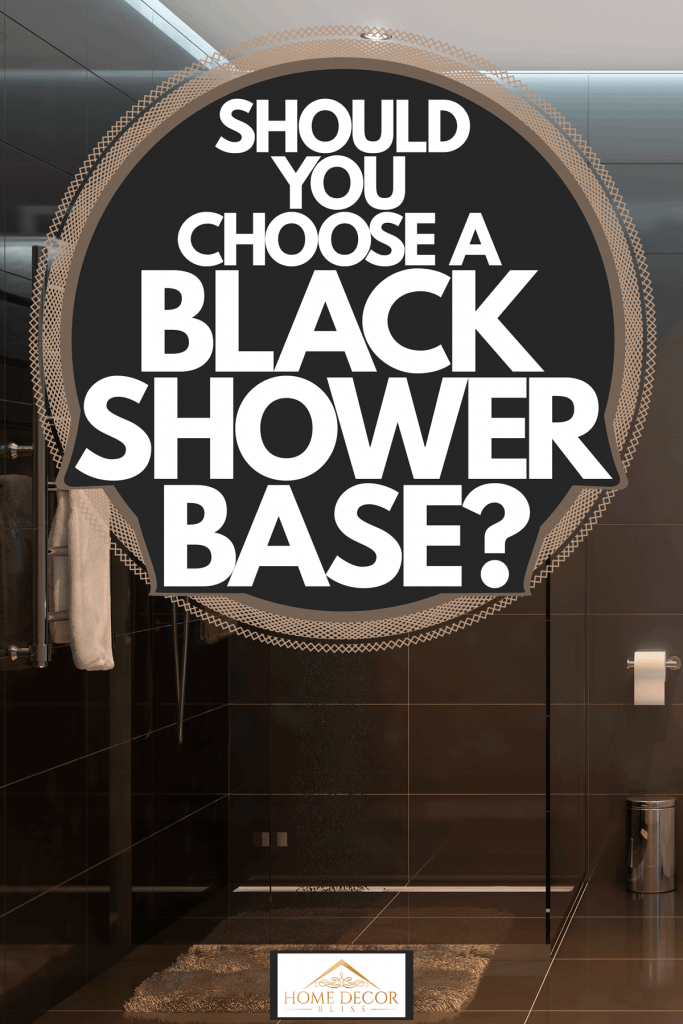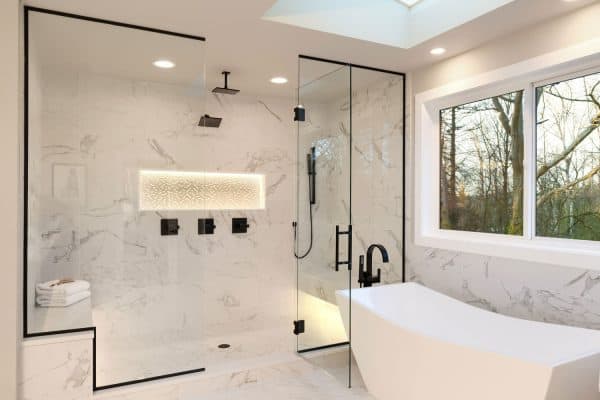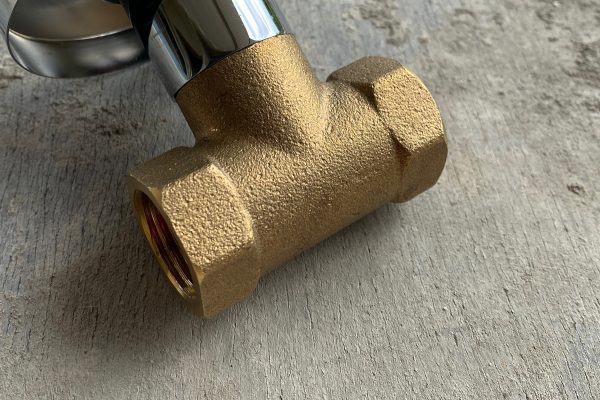Choosing the right layout for your shower base means choosing colors and materials that you feel confident with. Shower bases can come in various colors, from dark browns and grays to white or black shades. Black can make your entire shower area stand out. But is it a good color for a shower base? We've done some digging on this question, and in this post, we will discuss some considerations for black shower bases.
While black shower bases can bring a sense of elegance to your shower, it's just as important to consider the color's possible disadvantages. Here are the advantages and disadvantages of having a black shower base:
Advantages of a black shower base:
- It looks modern, sophisticated, and more up-to-date than many other colors.
- It gives you several non-traditional decorating options.
- Depending on the material, it may hide dirt and grime.
- It can create an interesting contrast with your personal items and other bathroom decors.
- Can help bathroom fixtures stand out and become a focal point in the room.
Disadvantages of a black shower base:
- Depending on the base's material, dirt and grime may be more visible than they would be in other colors.
- It can make the bathroom come off as sterile and cold, as opposed to warm and inviting.
- The base can make your bathroom appear smaller and closed in.
- It may require more frequent cleaning to keep it looking its best.
- If you don't use black grout, it can make dirty white grout stand out more.
As you can see, there are advantages and disadvantages to choosing a black shower base for your bathroom. It really comes down to personal taste and the type of look that you are going for. When deciding on the color and the type of shower base that you want, a few different factors come into play. Continue reading to learn more about these factors and how they can influence your decision.

How to choose the right shower base?
If you consider purchasing a new shower base for your bathroom, be sure to think about all aspects of the base before deciding on the right one. Here we will cover a few questions that you can consider before deciding on which base will work best.
Installation Methods
It may not surprise you to know that you can install shower bases in a few different ways. Most commonly, bases are installed using a recessed, raised, or ready-to-tile setup. If you are working with a contractor for the installation, they will guide you on the best option for your specific bathroom. The type of insulation will also depend on the material that you use for the base. Let's take a look at each type of insulation and what they encompass.
Recessed
A recessed shower base will have a walk-in area that does not include a step. This type of installation is most commonly used in full bathroom renovations or new construction projects. For this installation, you will need to install a recessed siphon so that the water can drain properly from the base.
Raised
A raised shower base is probably the fastest and easiest installation there is. With this installation, the base is placed directly on the floor's surface. Afterward, the installer will create a single step about an inch or so high at the shower entrance area.
Ready-to-tile
A ready-to-tile installation is great for anyone who has reduced mobility. This shower base is typically designed to go with tile layouts. When it is installed, it will include an integrated slope for the water drainage. This installation method is fairly inexpensive compared to others, and you can even make it a DIY project if you have experience cutting tiles and installing grout. The biggest thing to remember when using this installation method is that the base drain will need to be big enough to fit around the tile and meet any local plumbing code expectations.
Water Evacuation Methods
Another consideration to think about when looking at shower bases is the type of evacuation you'll need. Your shower's evacuation system can cause a myriad of problems if it is installed incorrectly or if it becomes backed up. This system consists of a flat-top drain, a siphon, and a network of pipes used to drain water from your shower base to the sewer system.
There are a couple of evacuation systems to consider. The first is a vertical drain beneath the base with raised tray. The other system goes under the base using a horizontal drain--this system is best when you don't have a lot of space to work with the bathroom.
Shower Base Shapes
One of the main options is the shape of the base. You can choose shower bases that are square, rectangular, oval, or round. Manufacturers are getting more creative with shower bases as consumers look for ways to make their bathrooms appear more interesting.
However, it is important to stay mindful that the shape of the base should match the enclosure. If the shower's enclosure has any gaps between it and the base, you will have a leaky shower--which, of course, is no fun.
What materials are shower bases?
Shower bases come in a variety of different materials. You can choose bases made of metal, plastics, resin, tile, fiberglass, acrylic, as well as other solid surfaces. The durability, installation requirement, comfort level, and maintenance requirements should be the biggest factors considered when determining the best shower base material. Let's take a look at them and discuss their features.
Fiberglass
Fiberglass is probably the most commonly used material for shower bases. It has a gel coat finish and is made of molded fiberglass that has been shaped and formed to fit shower floors. Fiberglass shower bases are lightweight, inexpensive, and can typically be found in various white, gray, and black shades. So to say, the colors and patterns available for this material are rather limited.
The biggest downside to these bases is that scratches can be noticeable, so proper maintenance is essential to keep them looking their best.
We may include affiliate links and curated AI content to highlight top design styles.
See this fiberglass shower base on Amazon.
Acrylic
It's safe to say that acrylic shower bases are probably the second most common type of shower bases purchased today --and it's easy to understand why. Acrylic shower bases are easy to clean, lightweight, durable, and they are available in a wide range of colors and sizes. Since the color on the material goes all the way through the surface, you won't see scratches as easily as you would on fiberglass. And if so, you can simply polish the scratches out.
On the downside, however, you will need to pay special attention to the type of cleaner that you use on an acrylic base, as caustic cleaners can damage the surface.
Cast Iron
Cast iron makes for a very durable and solid shower base. It's also a fairly common choice in most homes. Cast iron bases may be more expensive than fiberglass, but their durability and easy maintenance quickly make up for the higher price. Cast iron bases retain heat very well. They can also give your bathroom a more elegant look and match seamlessly with cast-iron tubs and sinks.
On the downside, cast iron bases can be very heavy to handle. They can also come with limited color options and shapes.
Tile
You can also use tile for your shower base. The tile can come as a pre-cast base, or you can build it from scratch if you are handy. When building your shower base with tile, always look for slip-resistant materials. Tile is very durable and can give you more control over the tiles' layout, color, and shape.
It's also fairly expensive compared to other materials. However, tile requires more frequent cleaning, as it may display dirt and grime easier and faster than other materials.
Can you just replace the shower base?
Yes, you can replace a shower base if it becomes old, damaged, or dysfunctional somehow. This is a bit of an extensive project, so it's best to ensure that you plan it out ahead of time. Whether you make it a DIY project or use a contractor, you'll need to determine the new type of base you want, the installation method, and the material you will use.
Replacing a shower base can be completed in about 4 to 10 hours, depending on how the old base was installed and the new base installment. Once you expose the flange and disconnect the base's drain, it's just a matter of replacing the surrounding grout and lifting the base from the floor.
Can you paint a shower base?
Yes, you may be surprised to know that you can paint your shower base if you are not happy with its current color. To do so, you will need to use epoxy paint specific to the base's material. It's best to do this with fiberglass, as there are several epoxies available that will adhere well to it. Also, you'll want to use waterproof paint and a good mold-fighting primer so that the paint will not chip or develop mold as soon as you start using the shower.
See this Kilz primer on Amazon.
Wrapping Things Up
We hope that this post has shown you the advantages and disadvantages of installing a black shower base. But before you go, be sure to check out our other posts:


![Marble walled shower wall, 5 Best Types Of Shower Wall Panels To Consider For Your Bathroom Renovation [The Ultimate Guide]](https://homedecorbliss.com/wp-content/uploads/2023/07/shutterstock_2138160219-600x400.jpg)

